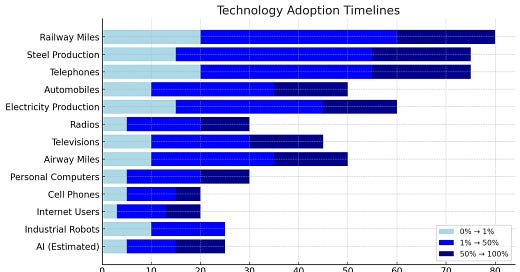AI Adoption Timeline Estimates
A major AI-driven acceleration in productivity in the next decade is unlikely/ It may take 25 years for AI to achieve full penetration.
0% to 1%: The initial phase, usually slow due to innovation, infrastructure, and public awareness.
1% to 50%: The rapid adoption phase, often driven by cost reduction, policy support, and network effects.
50% to 100%: The maturity phase, where adoption slows as the market saturates.
Adoption Speed Increases Over Time
Early industrial technologies (railways, steel, electricity) took 60-80 years for full adoption.
Mid-20th-century technologies (automobiles, radios, TVs) took 30-50 years.
Digital and internet-based technologies (PCs, cell phones, internet) were widely adopted in just 20-30 years.
Modern Technologies Have Shorter Early-Stage Adoption
Cell phones and the internet took only 5 years to go from 0% to 1%, much faster than earlier technologies.
Older technologies like railways and telephones took 20+ years to move from 0% to 1% due to infrastructure challenges.
Peak Growth Phase (1% → 50%) is Faster Now
Older industrial technologies took 30-40 years to reach 50% adoption.
Radios, TVs, and cars took around 20-30 years.
PCs, cell phones, and the internet only took 10-15 years to reach 50%.
Final Adoption (50% → 100%) Slows Down
This phase usually takes 10-20 years, as saturation sets in.
Newer technologies still see rapid completion phases, but slowing at high levels.
AI Adoption Estimates:
0% → 1% (2020 - 2025):
Early adoption phase with AI-driven automation, chatbots, and generative models.
Enterprises experimenting with AI in finance, healthcare, and software development.
1% → 50% (2025 - 2035, Estimated):
Mass adoption across industries, increasing integration into daily workflows.
AI-driven decision-making, automation, and personal AI assistants become mainstream.
Governments and businesses invest heavily in AI infrastructure.
50% → 100% (2035 - 2045, Estimated):
AI reaches near-total penetration in business and consumer applications.
Widespread autonomous systems, AI-driven healthcare, and education.
Potential regulatory frameworks and ethical considerations shaping the final stage of AI adoption.
This structured breakdown highlights how adoption speeds have evolved with time and technology type, with modern innovations reaching full adoption much faster than ever before. 🚀
Adoption rates have accelerated significantly, especially with digital and communication technologies.
Infrastructure-heavy technologies (rail, electricity) had the longest adoption curves, while software-based innovations (internet, mobile phones) scaled the fastest.
The modern tech revolution (post-1990s) has compressed the full adoption cycle to under 30 years compared to 50-80 years for pre-1950s technologies.
AI Adoption is Expected to be Faster than PCs and the Internet
PCs and the Internet took ~30 years to reach near-total adoption.
AI could reach full adoption in 25-30 years, driven by rapid advancements and data availability.
AI Will Likely Follow a Steep Adoption Curve
AI is already progressing through its early phase, similar to how cell phones and the internet quickly expanded.
The 1% → 50% phase (2025-2035) is expected to be the most rapid due to business adoption and innovation.
Maturity Phase May Be Longer (Regulation & Ethics)
The final adoption stage (50% → 100%) may take longer as AI governance, privacy concerns, and regulatory challenges slow full deployment.







